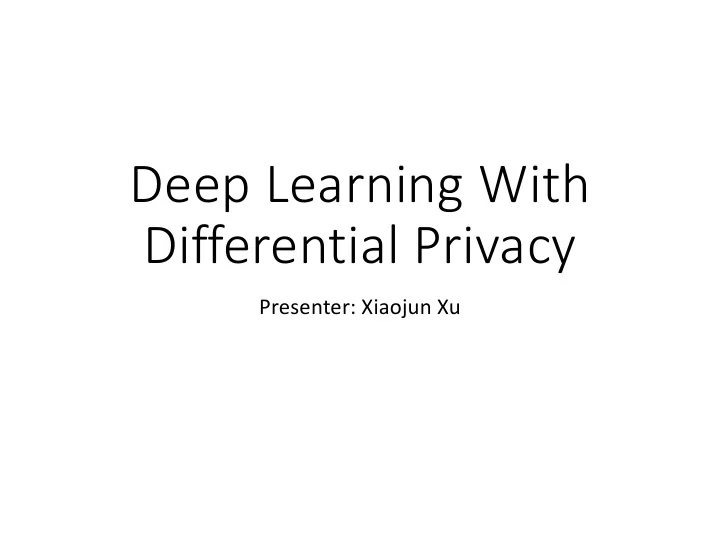

Deep Learning With Differential Privacy Presenter: Xiaojun Xu
Deep Learning Framework Autonomous Driving Gaming Face Recognition Healthcare
Deep Learning Framework Dataset Server Model
Privacy Issues of Training Data Dataset Server Model
What information will be leaked from the deep learning model? Dataset Server Model
Training Privacy Leakage • Model Inversion Attack Model inversion attacks that exploit confidence information and basic countermeasures (CCS’15) • Membership Inference attack • Infer whether or not a data case is in the training set. Membership inference attacks against machine learning models (Oakland’17)
Protecting Privacy of Training Data Dataset Server Model Differential Privacy
Differential Privacy(DP) • Protect the privacy of individuals while allowing global query. • e.g.: how many individuals in the database have property P? Individual Property P? Individual Property P? … … … … Alice Yes Output of D Alice Yes and D’ should Victim Yes be similar! Bob No Bob No … … … … Database D’ Database D
Differential Privacy(DP) • Solution: randomize the query answer (e.g. by adding random noise ! .) Individual Property P? Individual Property P? … … … … Alice Yes Alice Yes Victim Yes Bob No Bob No … … … … 172 +!′ 171 +!
Differential Privacy • Definition: Let A: # → % be a randomized function database domain # to output domain % . Then A is &, ( -differentially private if for any S ⊆ % and any two databases +, +′ which differs in only one element: Pr / + ∈ 1 ≤ exp & Pr / + 6 ∈ 1 + (
Differentially Private Mechanism • Take function !(#) , add noise %(#) = ! # + ( • Noise level is related with: • ) and * . • The maximal possible difference between !(#) and !(#′)
Differentially Private Mechanism • Take function !(#) , add noise %(#) = ! # + ( • When adding Gaussian noise, the scale should be: 2 ln(1.25 ) = 0 ) Δ 2 /4
Deep Learning with DP / Dataset1 0 1 / Dataset2 0 2 Pr # $ ∈ & ≤ exp + Pr # , ∈ & + .
Achieving DP Deep Learning • How to achieve DP for deep learning model? • Directly adding noise to ! . • Not releasing model parameters, and during application, adding noise to the model output. • Adding noise in the process training.
Training Deep Learning Models • Model function ! " • Training dataset # = % & , ( & , … , % * , ( * • Repeat: • Sample a batch from # . • Learn from the batch by calculating update Δ, . • , ≔ , + Δ,
Deep Learning With DP
Deep Learning With DP
What is the bound? • At each step the gradient is !, # -DP w.r.t. the group(batch). • What is the DP guarantee after many steps for the gradient w.r.t. the dataset? One step, One step, Many steps, Within the group Within the dataset Within the dataset !,#
Amplification Theorem • ! : dataset size; " : size of each group • # = "/! • Amplification Theorem: if gradient is &, ( -DP within the group, then it’s ) #& , #( -DP within the dataset. One step, One step, Many steps, Within the group Within the dataset Within the dataset &,( )(#&),#(
Basic Composition Theorem • Applying an ! " , $ " -DP algorithm with an (! & , $ & ) - DP algorithm together will give an ( ! " + ! & , $ " + ) $ & -DP algorithm. • So after ) steps an (!, $) -DP algorithm is ()!, )$) - DP. One step, One step, Many steps, Within the group Within the dataset Within the dataset !,$ *(+!),+$ * )+! , )+$
Strong Composition Theorem • Applying the same (", $) -DP algorithm & times will + give an (O " &log , &$) -DP algorithm. , One step, One step, Many steps, Within the group Within the dataset Within the dataset ",$ -(."),.$ - ." &log 1/$ , &.$
Moments Accountant • One major contribution of the paper! • The noise at each step is Gaussian noise. One step, One step, Many steps, Within the group Within the dataset Within the dataset !,# $(&!),&# $ &! ( , #
Comparison Approach Overall epsilon Overall delta Basic Composition ! "#$ "#% Advanced Composition "#% ! #$ "log 1/% Moments Accountant % ! #$ "
Experiments • MNIST: 70000 gray-level images for hand written digits with size 28 × 28.
Experiments • CIFAR10: 60000 colored images of 10 classes with size 32 × 32.
Experiments • MNIST: DP-PCA + DP-NeuralNetwork • CIFAR-10: Pretrained Conv Layer + DP-NeuralNetwork
Experiment Results - MNIST • Acc without DP: 98.3%
Experiment Results – CIFAR10 • Acc without DP: 80%
Effectiveness • What can DP defend? • What cannot DP defend?
Training Privacy Leakage • Model Inversion Attack Model inversion attacks that exploit confidence information and basic countermeasures (CCS’15) • Membership Inference attack • Infer whether or not a data case is in the training set. Membership inference attacks against machine learning models (Oakland’17)
What can DP protect? • Privacy of individual data in the dataset. • Membership Inference Attack • Extracting secrets from language models • My SSN is “xxx-xx-xxxx” The Secret Sharer: Measuring Unintended Neural Network Memorization & Extracting Secrets (arXiv preprint)
What can’t DP protect? • Privacy leakage because of global information of the dataset. Deep models under the GAN: information leakage from collaborative deep learning (CCS’17)
Q&A
Recommend
More recommend